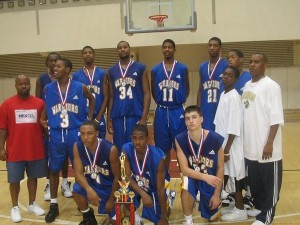

Fourteen-year-old Tyrell Peterson has been playing basketball in Hunting Park since he was old enough to pick one up. His mother, Tamika Hall, supports his love for the game and vows to ultimately let him choose his path. “Basketball is his thing, not mine,” she says. “And I would never take that from him. It’s something he really likes, and it actually helps to keep him focused.”
Peterson is a ninth-grade student at the recently relocated Multi-Cultural Academy Charter School on Broad Street in Hunting Park. He was taught to play basketball by his father, James Peterson, and his half-brother, Maurice Peterson. His father was something like a coach: he encouraged his sons while working them hard enough to become great athletes.
Peterson hasn’t seen his father since his 10th birthday. A few months after he turned 13, his brother Maurice, then 17, was struck and killed by a drunk driver. “He was close with his brother, even after his father left,” says Hall. “The accident really hurt him, but he says he feels closer to Maurice when he’s on the [basketball] court. So he plays ball. When he starts feeling sad, he plays ball.”
In Hunting Park, the violent crime rate, which includes homicide and manslaughter, is high, while educational scores are low. Most crimes are related to drug activity. Only 46 percent of residents in this area obtain a high school diploma or equivalent. The percentage of residents that complete degree programs is just over three percent.
“He was a good dude,” says Peterson of his late brother, as he dribbles a basketball with “#8 written on one side in permanent marker, and “RIP Reese” written on the other. “Reese was gonna be the next Kobe [Bryant]. He was nice on the court, and he got good grades, and always told me I better get good grades too. But he stayed off the streets. He didn’t do all the stuff most guys around here do.”
The Multi-Cultural Academy Charter School does not have a basketball program comparable to that of the area’s public schools. But the education Peterson will gain there looks much more promising. With high retention and graduation rates, He and his mother agree that, while basketball is important to him, it is no substitute for a quality education. “I can play ball anywhere,” says Peterson. “Philly has a lot of different leagues and camps that kids my age can get into.”
Peterson has played in the city’s Police Athletic League (PAL) since the age of nine. He plans to try out for the Hunting Park Warriors, an Amateur Athletic Union (AAU) team based out of his community. The Warriors, once sponsored by NBA-star Rasheed Wallace, is a summer traveling team that gives high school-aged players an opportunity to compete against other high school athletes in different cities. During the team’s existence, it has competed against AAU teams in several states, mostly along the East Coast. Its reach, however, has gone as far as Kentucky and even Nevada.

The team‘s namesake, established in 1946 as the Philadelphia Warriors, is known best for its star Wilt Chamberlain, signed in 1959. The team won the championship in the Basketball Association of America’s (BAA) inaugural season. The league would eventually become the National Basketball Association. In 1962, the franchise relocated to San Francisco. It operated as the San Francisco Warriors until 1971, when its name was changed to the current Golden State Warriors.
Not unlike many inner-city children, basketball is therapy for Peterson. It’s his passion, his connection to his brother, and something he’s good at. For many inner-city children, participation in sports programs serves some strong purpose in their lives. It gives them dreams, keeps them physically fit and provides an emotional release when they are feeling sad, frustrated or abandoned. Parents like Hall find comfort in sports interests because they keep children occupied in a positive way, and off of the streets that have consumed more than their fair share of what once were “good” children.

Philadelphia public and parochial schools offer sports programs beginning at the middle-school level. These programs, not unlike high school and college athletics, have academic requirements in order to participate. It is rare that children are dropped from these programs for falling below academic guidelines. Their participation in these programs gives them an incentive to perform well in the classroom and, in most cases, they do. Whether they choose to play basketball, football, soccer, lacrosse or baseball, there are programs throughout Philadelphia that aim to keep the youth involved and out of trouble.
James Murphy Sr., who grew up on the east side of Hunting Park, is a fan of sports programs for children – especially on the middle- school level.
“When I was growing up, there was no middle school sports program,” says Murphy Sr., who played in Philadelphia’s Lighthouse Baseball League from the age of seven. Lighthouse, a chartered member of Little League International, continues to operate from April to September each year. Containing both in-house and traveling teams, the league involves more than 450 children ages five to 21. Lighthouse Field, located at Front at Erie, is just blocks from where Murphy grew up. His son, James Murphy

Jr., currently plays baseball for Grover Washington Middle School.
“I think middle school sports are great,” says Murphy Sr. “I think it teaches the kids how to prepare themselves for life, to interact with other children like themselves.”


I am interested in learning about your program. I have a 11 yr old daughter who need some guidance..my number is 267 975 1310 thank you…